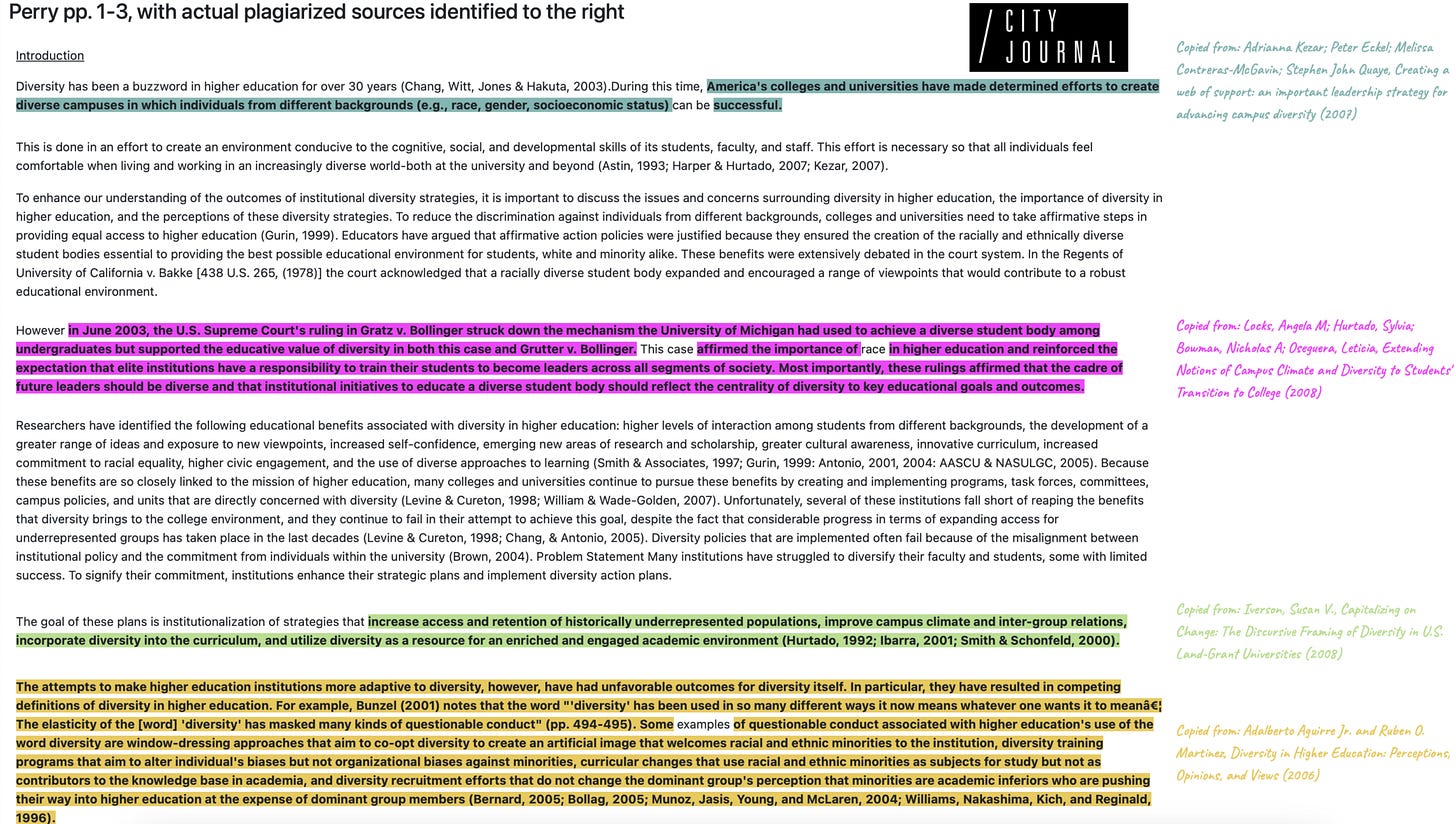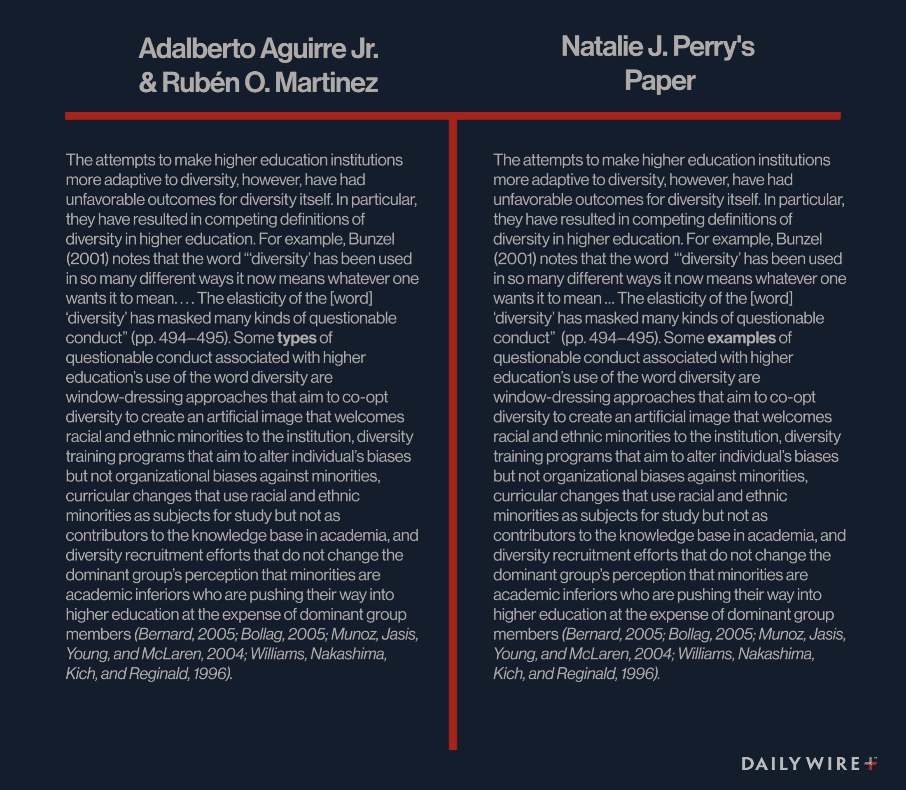Academic Dishonesty at UCLA
A prominent administrator at the university’s medical school appears to have plagiarized.
Recent headlines about UCLA School of Medicine suggest that the institution has lost its focus. Instead of brushing up on organic chemistry, its students were subjected to lessons on “Indigenous womxn” and “two-spirits.” Future doctors had to take a class on “structural racism” and were led in a “Free Palestine” chant by a Hamas-praising guest speaker. The school made plans to segregate students by race for courses on left-wing ideology, and two of its psychiatry residents championed “revolutionary suicide.”
Why has the school charted this course? One reason is its commitment to diversity, equity, and inclusion ideology. UCLA has a DEI program called “Cultural North Star,” and at the medical school, it is led by Natalie J. Perry, whose official title is Cultural North Star Lead. Her UCLA biography says that her job is to “embed our aspirational Cultural North Stars [sic] value [sic] in our organizational DNA.” UCLA honored Perry last month for teaching students to “do what’s right,” saying her “empathy and radical listening” are to thank for her “success as an educator and a leader.”
According to a Daily Wire and City Journal investigation, however, Perry’s academic career is based on fraud. Perry published her Ph.D. dissertation in 2014 at the University of Virginia about college diversity programs. An analysis of the paper found it ridden with the worst sort of plagiarism, reproducing large swaths of text directly from several other authors, without proper citations. The scale of the plagiarism suggests that Perry lacks both ethics and competence and raises questions about academic programs that push DEI.
Perry’s dissertation lifted passages from ten other papers. In key portions of her text, she copied almost every paragraph from other sources without attribution. She fails even to mention at least four of the ten plagiarized papers anywhere in her dissertation.
Let’s review some examples.
The first three pages of Perry’s paper, “Faculty Perceptions of Diversity at a Highly Selective Research-Intensive University,” suggest that she did not even bother to read beyond the first page of papers from which she stole. Her dissertation’s second sentence reproduces verbatim part of a sentence on the first page of a paper by Adrianna Kezar, Peter Eckel, Melissa Contreras-McGavin, and Stephen John Quaye. Her third paragraph, without citation, lifts more than 100 words from the first page of a paper by Angela Locks, Sylvia Hurtado, Nicholas Bowman, and Leticia Oseguera.
Each colored portion of the below text was taken from a different author:
In some cases when Perry did include parenthetical citations, she wasn’t citing the papers whose text she had lifted. Instead, she simply reproduced the citations included in those stolen excerpts.
Take the above paragraph, which ends with “(Bernard, 2005; Bollag, 2005; Munoz, Jasis, Young, and McLaren, 2004; Williams, Nakashima, Kich, and Reginald, 1996).” Perry was not synthesizing those authors. Instead, the citation was part of Adalberto Aguirre and Ruben Martinez’s paper, from which she apparently copied and pasted, without attribution.
A core part of Perry’s dissertation involved summarizing work done by professors Robert Quinn and John Rohrbaugh. Instead of citing them directly, however, Perry cribbed summaries from other academics. Perry copied and pasted almost all of a nearly thousand-word passage from a paper by Chad Hartnell, Amy Yi Ou, and Angelo Kinicki, without quoting the authors.
Consider, for example, the following excerpt from Perry’s dissertation. The italicized portions were taken verbatim from Hartnell, Yi Ou, and Kinicki’s paper:
The CVF is widely used in organizational literature (Ostroff et al., 2003). Measures of organizational culture that directly or indirectly assess the CVF have been administered in over 10,000 organizations globally (Cameron et al., 2006) within the following academic disciplines: management, marketing, supply-chain management, accounting, social services, hospitality, and health care. Further, the reliability and content validity of Cameron and Ettington's (1988) measure of the CVF has been empirically supported in studies utilizing multitrait-multimethod analysis (Quinn & Spreitzer, 1991), multidimensional scaling (Howard, 1998), and structural equation modeling (Kalliath, Bluedorn, & Gillespie, 1999). Surprisingly, prior to 2011, there had been limited assessment of the theoretical foundation of the CVF despite its reported content validity and widespread use in research and practice.
The rest of Perry’s analysis of Quinn and Rohrbaugh’s work is largely copied, unquoted and unattributed, from a 2003 paper by John Smart. Below are pages 13 and 14 of Perry’s paper, outlining its “Theoretical Framework,” with the italicized text coming directly from Smart:
To develop this theory Quinn and Rohrbaugh (1983) asked a panel of distinguished organizational theorists to evaluate the similarity between every possible pair of 39 indexes of organizational effectiveness derived from Campbell’s (1977) exhaustive synthesis of criteria used to assess the performance of organizations. The results of this analysis revealed three basic dimensions underlying the judgments of respondents. The first dimension is organizational focus, which distinguishes organizations that have an internal emphasis on the development of people from those that have an external focus on the development of the organization. The second dimension is organizational structure, which distinguishes between organizations that have an emphasis on stability and control from those that have an emphasis on flexibility and innovation. The third dimension is organizational means and ends, which distinguish between organizations that emphasize processes such as planning and establishing goals from those that emphasize resulting outcomes such as productivity and efficiency.
In a section titled “Positioning Diversity Leadership in Higher Education,” Perry copies almost every sentence from one of several other papers. In no case does she credit the actual source:
Finally, in a section on organizational culture, Perry duplicates language from a variety of other authors:
Finally, in a section on organizational culture, Perry duplicates language from a variety of other authors:
The positionality of the participants informed the perspective on the origins of the commission. /in response to the needs of the varios [sic] stakeholders within the university, the commission addressed issues of diversity on the faculty, undergraduate, graduate, and university level.
The section of original text suggests that her plagiarism could be used to mask glaring academic deficiencies. Moreover, Perry in her references section fails to list some of the papers that she cites parenthetically in the body of the dissertation—a telltale sign that she had simply copied those citations from somewhere else. Legitimate academic inquiry would not excuse such shoddy work.
Perry and UCLA did not return requests for comment.
Entrepreneur Mark Cuban recently argued that DEI policies don’t necessarily lower an organization’s expectations. But for Harvard, UVA, and UCLA Medical School—where Perry earned her master’s, Ph.D., and DEI position, respectively—this is evidently not the case. These institutions have dramatically lowered expectations for favored groups and pushed a cohort of “scholars” through the system without enforcing basic standards of academic integrity.
Ultimately, Natalie Perry is to blame for her misconduct. But these institutions of higher learning share some fault for permitting such shoddiness to stand unchallenged.
This article was originally published in City Journal and Daily Wire.










Thank you for pursuing this important, joyless work on behalf of those of us who could not stomach reading such dreck.
In a fraudlent discipline, are we surprised by deeper fraud?